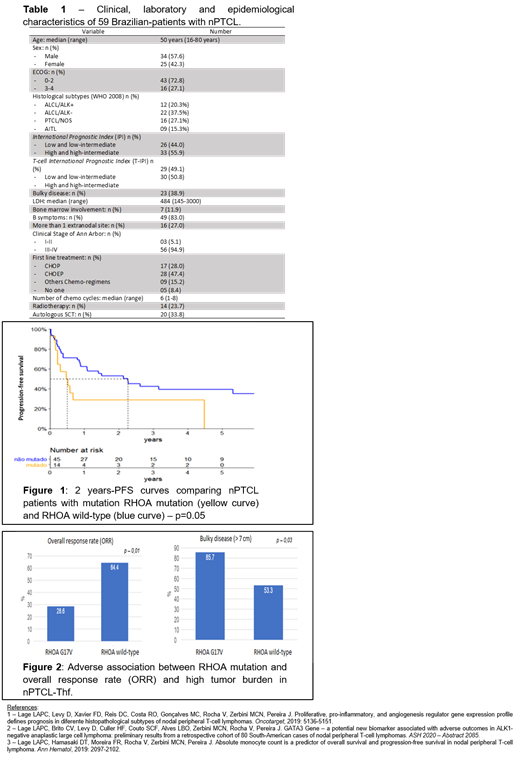Abstract
Introduction: Nodal PTCL constitute a rare group of aggressive malignancies with heterogeneous clinical-biological presentation and outcomes. In the last decade, its pathophysiological knowledge has been improved, with descriptions of gene mutations associated with epigenetic phenomena (IDH2, TET2 and DNMT3A) and of the RHOA G17V mutation playing a fundamental role in the lymphomagenesis. However, the prognostic impact of these alterations is still controversial, and particularly, in the case of the RHOA mutation, it has never been previously accessed in the literature. Our group has described and validated biomarkers with potential prognostic impact in nPTCL patients, including overexpression of the genes CCNA2, GATA3 and monocytosis in peripheral blood [1,2,3]. The identification of new potential molecular biomarkers can refine the prognostic stratification of these tumors and allow identification of targets for future specific therapies. The aim of this study was to evaluate the frequency and prognostic impact of mutations in the IDH2, TET2, DNMT3 and RHOA genes in Brazilian patients with nPTCL.
Methods: In this observational, retrospective and unicentric study, we analyzed the clinical-epidemiological characteristics, outcomes and mutational profile of 59 Brazilian patients with nPTCL treated at the HC-FMUSP, from January 2000 to December 2017. All cases were submitted to centralized histopathological review and were classified according to the criteria proposed by WHO-2008. Cases initially categorized as PTCL/NOS were later reclassified according to WHO-2016 criteria. FFPE-tumor samples from patients with PTCL/NOS, AITL, ALK+/ALCL and ALK-/ALCL were submitted to DNA extraction using QIAmp DNA FFPE kit. For amplification of specific products of target-genes primers flanking the hot spots regions were designed. After this step, the PCR products were submitted to first generation sequencing in 3500 Genetic Analyzer. Absolute and relative frequencies of mutations were accessed for the total cohort and its pathological subtypes. OS and PFS curves were constructed using the Kaplan-Meier method. Log-rank test was used to estimate the prognostic impact of mutations.
Results: The clinical-epidemiological characteristics of the 59 Brazilian-patients with nPTCL are summarized in Table 1. With a median follow-up of 3.70 years (0.90-12.4 years), the estimated 2-years OS and PFS were 59.1% and 47.2%, respectively. ORR was 55.9% (33/59), with early relapse rate (< 12 months) of 14.3% (5/59) and global death rate of 52.5% (31/59). In the total cohort, we found a mutation frequency of 3.4% (2/59) for the IDH2 gene, 62.7% (37/59) for DNMT3A, 23.7% (14/59) for RHOA and 50.8% (30/59) for TET2. There was no statistically significant difference in the frequency distribution of IDH2, DNMT3A and TET2 mutations between the different histological subtypes of nPTCL. However, there was a statistical trend towards a higher occurrence of the RHOA mutation in the AITL and PTCL/NOS subtypes (3/9-33.3% and 7/16-43.7%, respectively; p=0.07). Among 7 cases with RHOA mutation classified as PTCL/NOS according WHO-2008 criteria, 6/7 (85.7%) expressed the PD-1 marker in immunohistochemistry, being reclassified as nPTCL with THf phenotype according to WHO-2016 criteria. So, the mutation RHOA was predominantly found in THf cell-derived neoplasms in our cohort. The mutational status of DNMT3A, RHOA and TET2 genes had no prognostic impact on OS, with p=0.85, p=0.13 and p=0.95, respectively. The same was observed in relation to PFS for the DNMT3A (p=0.70) and TET2 (p=0.52) mutations. However, the presence of the RHOA mutation was associated with the unfavorable PFS in our cohort (HR:1.98, p=0.05). We observed 2-year PFS of 28.6% (95% CI: 8.8-52.4%) for mutated-RHOA cases versus 52.9% (95% CI: 37.3-66.3%) for wild-type-RHOA patients (p=0.05) [Figure 1]. We also demonstrated that RHOA mutation was a predictor of lower ORR to first-line therapy (p=0.01) and was associated with high tumor burden (p=0.03) [Figure 2].
Conclusion: In this study, for the first time was demonstrated the unfavorable prognostic impact of the RHOA mutation in patients with nPTCL-Thf (AITL and nPTCL-THf), making it a potential molecular biomarker predictor of poor-PFS, associated with resistance to primary therapy and with high tumor burden. Such results are preliminary and will need to be validated in series with a larger number of cases.
No relevant conflicts of interest to declare.


